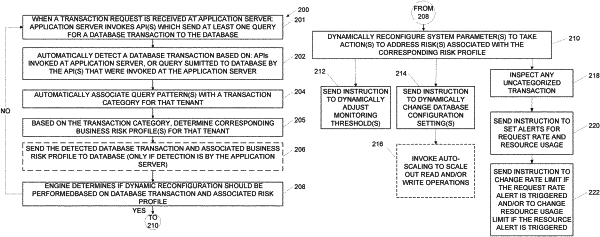| CPC H04L 63/102 (2013.01) [H04L 63/1416 (2013.01); H04L 63/1425 (2013.01); H04L 63/1433 (2013.01); H04L 63/1466 (2013.01)] | 19 Claims |

|
1. A method for dynamically reconfiguring a database system of a tenant based on one or more risk profiles of the tenant, wherein the database system of the tenant comprises at least one database of the tenant, the method comprising:
in response to a request received from a client of the tenant: automatically detecting a database transaction based on the request, the request comprising a query submitted to the database system or an application programming interface (API) invoked at the database system, wherein the detected database transaction has one or more query language patterns;
analyzing the one or more query language patterns associated with the detected database transaction to automatically associate the detected database transaction with a corresponding transaction category of a plurality of transaction categories for that tenant when the one or more query language patterns are associated with the corresponding transaction category of the plurality of transaction categories, the corresponding transaction category of the plurality of transaction categories having at least one query language pattern associated therewith:
when the detected database transaction is not associated with the corresponding transaction category:
inspecting the detected database transaction; and
sending an instruction to a database monitoring and alerting system to set at least one of a request rate alert and a resource usage alert;
when the detected database transaction is associated with the corresponding transaction category:
determining a corresponding risk profile based on input data for that tenant based on the corresponding transaction category, wherein each transaction category of the plurality of transaction categories has an associated risk profile for that tenant; and
dynamically reconfiguring a monitoring threshold of the database system based on the corresponding risk profile to allow the detected database transaction to proceed without triggering an alert based on the corresponding risk profile.
|